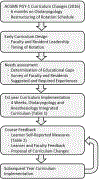Integrated Otolaryngology-Anesthesiology Clinical Skills and Simulation Rotation: A Novel 1-Month Intern Curriculum
- PMID: 30938180
- PMCID: PMC6635073
- DOI: 10.1177/0003489419840682
Integrated Otolaryngology-Anesthesiology Clinical Skills and Simulation Rotation: A Novel 1-Month Intern Curriculum
Abstract
Objectives: Current Accreditation Council for Graduate Medical Education (ACGME) requirements allow PGY-1 otolaryngology-head and neck surgery (ORL-HNS) residents to spend 6 months on service, prompting reconsideration of educational best practices for the first-year resident experience. The aim of this study was to determine feasibility and value of a 1-month PGY-1 otolaryngology clinical skills rotation integrated with anesthesiology to complement clinical ORL-HNS rotations.
Methods: Our institution developed a 1-month rotation focusing on procedural simulation and airway management as a collaborative effort between ORL-HNS and anesthesiology. Logistics of curriculum design and implementation in the first 2 years are described. Learner outcome measures include pre- and postintervention Likert scale measures of knowledge and confidence. Statistical assessment of curriculum efficacy includes Wilcoxon sign rank test and effect size (Cohen's d).
Results: The described rotation was successfully implemented for 8 entering PGY-1 residents in the 2016-2017 and 2017-1018 academic years. Learners reported significant improvement in knowledge and confidence (5-point Likert scale, all P < .0001) in each of the following grouped domains following the intervention: anesthesia skills (pre 2.79, post 4.02), anesthesia knowledge (pre 2.31, post 3.50), anesthesia overall preparedness (pre 2.75, post 4.04), otolaryngology skills (pre 2.90, post 4.19), otolaryngology scenarios (pre 2.80, post 4.00), and otolaryngology overall preparedness (pre 2.38, post 3.75). Very large effect sizes (Cohen's d, range = 1.6-2.9) were observed.
Conclusion: Changing rotation structure in ORL-HNS training programs provides an opportunity to develop novel rotations with high educational impact. Early outcome data suggest that the described clinical skills rotation is practically feasible and was perceived to have measurable value as part of the PGY-1 curriculum.
Keywords: PGY-1; anesthesiology; boot camp; curriculum development; intern; otolaryngology; simulation.
Conflict of interest statement
Figures
References
-
- Accreditation Council for Graduate Medical Education. 2016. ACGME Program Requirements for Graduate Medical Education in Otolaryngology https://www.acgme.org/Portals/0/PFAssets/ProgramRequirements/280_otolary.... Accessed March 15, 2017.
-
- Musbahi O, Aydin A, Al Omran Y, Skilbeck CJ, Ahmed K. Current Status of Simulation in Otolaryngology: A Systematic Review. J Surg Educ 2017; 74:203–215. - PubMed
-
- Malekzadeh S Simulation in Otolaryngology. Otolaryngol Clin North Am 2017; 50:xvii–xviii. - PubMed
-
- Chin CJ, Chin CA, Roth K, Rotenberg BW, Fung K. Simulation-based otolaryngology - head and neck surgery boot camp: ‘how I do it’. J Laryngol Otol 2016; 130:284–290. - PubMed
MeSH terms
Grants and funding
LinkOut - more resources
Full Text Sources


